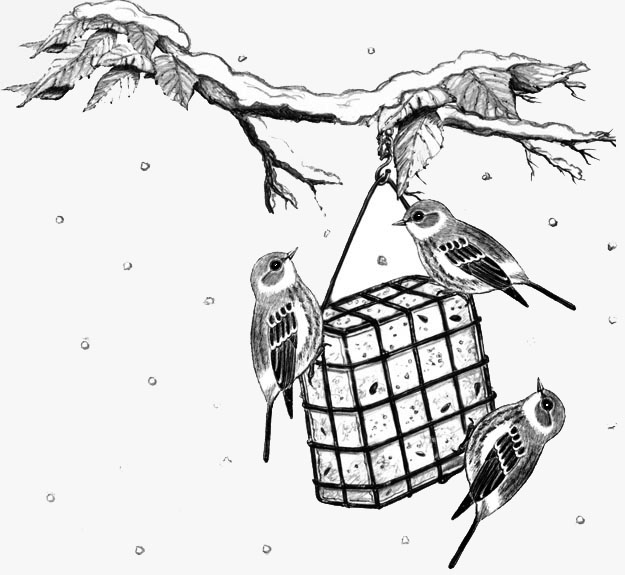
Dear Bird Folks,
You have always told us that goldfinches are strict vegetarians, so I was surprised to look out my window and see several finches eating from my suet feeder. (See attached photo.) I guess things have changed.
– Tom, Barnstable, MA
No, they haven’t, Tom,
Things haven’t changed at all. Goldfinches still find eating meat disgusting, and well they should. The barbaric birds in your photo (which is very nice, by the way) aren’t goldfinches. They are Yellow-rumped Warblers. Yellow-rumped Warblers are attractive birds, but they have dark souls. They’ll eat meat and not think twice about it. As punishment for this bad dietary choice they have been saddled with the embarrassing name of yellow-rumped. That will teach them. Nothing wants a name with “rump” in it. Rumpelstiltskin certainly didn’t. He was so self-conscious about his name he wouldn’t tell the miller’s daughter what it was. She had to guess. Then there’s rump roast. Do people still eat that? Meat is gross enough, but how desperate does someone have to be to eat a rump? Okay, I’m done talking about rumps.
Warblers are small, typically colorful songbirds that fly to North America in the spring to breed, but leave at the end of the summer. They migrate back to Central and South America to avoid our fabulous winters and because their favorite foods will soon be in short supply. For the most part, warblers are insect eaters. Nothing satisfies their hunger like swallowing some lovely plant lice or bark beetles. Yellow-rumped Warblers are an exception to this rule. Unlike their warbler cousins, yellow-rumps enjoy a more balanced diet. They switch to fruit as soon as those delicious bark beetles become hard to find. Their flexible diet allows yellow-rumps to remain in colder climates throughout the winter. When the bugs are gone Yellow-rumped Warblers easily switch to eating juniper, Virginia creeper or honeysuckle berries. But their most important food source is bayberries. Yellow-rumps are one of the few birds that are willing to ingest the waxy, fragrant berries. This not only gives yellow-rumps an uncontested food supply, but it allows them to have the best-smelling poop in the bird word.
In the winter, Yellow-rumped Warblers are fairly dull birds. They are mostly brown, with wing bars and a small patch of yellow on each side. This yellow patch, plus the wing bars and the overall drabness, could trick some people (and by some people, I mean you, Tom) into thinking they are seeing goldfinches, which are also dull in the winter. But these warblers have one thing that goldfinches don’t have: their namesake yellow rumps. No matter the time of year, Yellow-rumped Warblers always have their yellow rumps. The yellow maybe hidden when their wings are closed, but the minute they open their wings it becomes quite clear how they earned their name.
In January it’s easy to see how folks would confuse dull goldfinches with the equally dull Yellow-rumped Warblers, but there is no chance of mistaking these two birds when spring arrives. In the breeding season the drab, brown feathers of the yellow-rumps molt into rich gray. (I know “rich gray” sounds like an oxymoron, but look at a picture and you’ll see.) In addition, the yellow on their sides becomes more pronounced, their throats become bright white and the birds gain handsome black masks, making them look like the Lone Ranger. (Question: Didn’t the Lone Ranger have a sidekick? Wasn’t he always with Tonto? Then why is he called the “Lone” Ranger? Just wondering.)
Yellow-rumped Warblers aren’t typical Cape Cod feeder birds. To begin with, they aren’t here in the summer. They spend June, July and August on their breeding grounds, which extends from New England (just not Cape Cod) throughout most of Canada and Alaska. They return in September while we still have plenty of bugs for them to eat. When frost creates a scarcity of insects the birds turn to the aforementioned fruit and berries. At this point, the warblers are still happily eating on their own and have little use for our feeders, but that can change when winter’s snow and ice make it harder for them to forage. The day after our most recent snowstorm a steady stream of customers reported seeing yellow-rumps on their feeders. Some folks knew exactly which birds they were seeing, while others needed our help to identify them, and still others just called them goldfinches. (Gee, I wonder who that was.)
How do we attract Yellow-rump Warblers to our yards? As you mentioned in your question, suet is a good choice. The birds seem to be less interested in seeds, although I’ve had several reports of yellow-rumps eating on peanut feeders. Offering water is also a good way to attract them. This past week I’ve had a number of yellow-rumps drinking from my heated birdbath. (I guess they needed water to wash down the nasty suet.)
I know I’ve teased you about confusing Yellow-rumped Warblers with goldfinches, Tom, but you aren’t alone. At first glance, the two birds do look somewhat similar. The best way to know for sure if you are seeing a warbler or a finch is to look for the yellow spot at the base of the tail. If you see a yellow rump, you know it’s not a finch. You could also try sniffing the bird’s poop to see if it smells like bayberries, but I think I’d look for the yellow spot first.